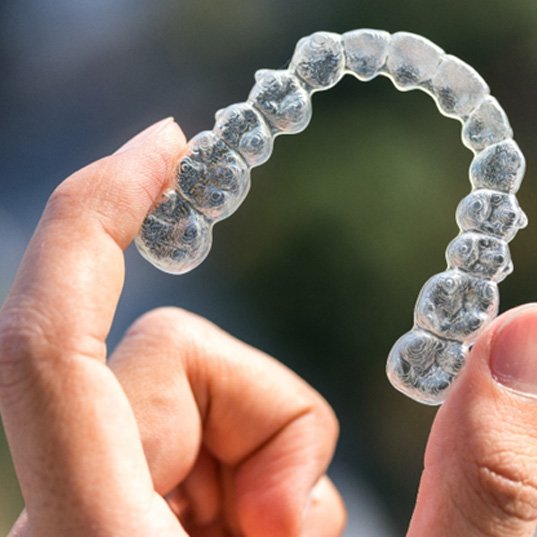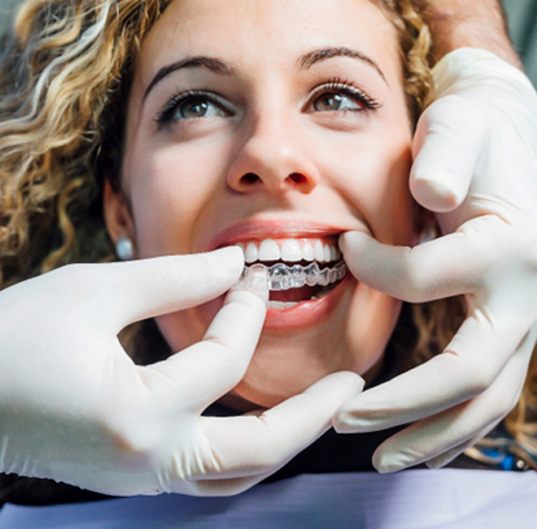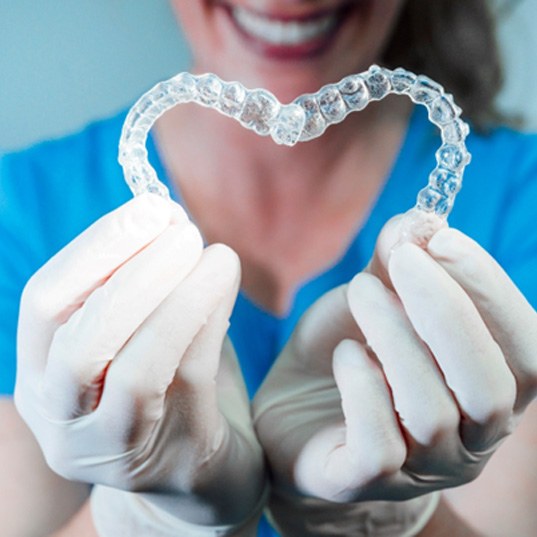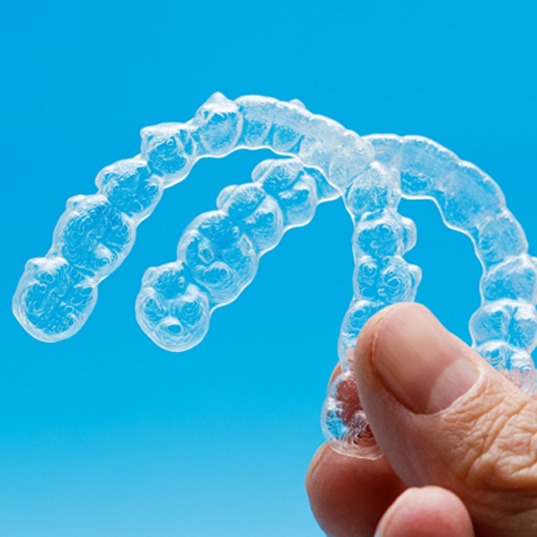Invisalign Clear Aligners – Naperville, IL
Say Goodbye to a Crooked Smile
If you didn’t get braces when you were younger, you may think that you’ve missed the boat on straightening your teeth. However, that couldn’t be further from the truth! At Pediatric Dentistry & Orthodontics, we offer Invisalign in Naperville to help you achieve your best smile. The clear aligners are a more aesthetically pleasing option that’s perfect for young adults. Continue reading or give our office a call today to learn more about this modern orthodontic treatment! today to schedule your initial consultation for traditional braces in Naperville!
How Invisalign Works

Unlike traditional metal braces, Invisalign works by using a series of clear aligners to make gradual improvements to your smile. We’ll use impressions of your mouth to custom-make these plastic trays, with each one representing a different stage of your teeth as they’re slowly shifted toward the desired position. You’ll be instructed to wear each aligner for a predetermined amount of time, which is usually two weeks. In addition, you’ll have to visit our office regularly to ensure things are moving according to plan!
Indications for Invisalign

Invisalign is a wonderful orthodontic solution that can address multiple issues, including:
Crowded Teeth
Do you feel like you have too many teeth in your mouth? That’s often because of crowding, which can interfere with your oral hygiene routine. If left untreated, dental misalignment can increase your risk of oral health problems like gum disease and tooth decay. With Invisalign, you can move your teeth into a more ideal position for a healthier grin!
Gaps Between Teeth
Having gaps in your smile isn’t just unsightly – it can also make you more susceptible to cavities and infection. This is mainly because food particles can easily get stuck in the spaces between your teeth, leading to decay and bad breath. Fortunately, Invisalign can push your teeth closer into a better position for a more attractive grin.
Bite Alignment
A misaligned bite can place unnecessary pressure on your temporomandibular joint (TMJ). If left unchecked, it can lead to problems like TMJ disorder and teeth clenching/grinding. The good news is that Invisalign can address overbites, underbites, and crossbites to make you feel more comfortable.
Benefits of Invisalign

Over the last two decades, Invisalign has helped millions of patients achieve their smile goals (more than 12 million, to be more exact). It’s an incredibly popular treatment thanks to the following benefits:
Shorter Average Treatment Timeline

No one wants to wait longer than they have to for their dream smile. The good news is that the average treatment timeline with Invisalign is significantly shorter than traditional braces (between 12-18 months). While the exact length of your teeth-straightening journey will depend on factors like the complexity of your case, the key to staying on-track for each patient is the same: follow the guidelines we provide, like making an active effort to wear your trays for 20-22 hours a day.
Discreet Appearance

Since traditional braces use noticeable brackets and wires to address orthodontic problems like overcrowding and crossbites, it’s common for patients to develop a habit of covering their mouth when they laugh or keeping their lips closed when they smile. With Invisalign, you won’t feel self-conscious about your braces because they are completely see-through! As a result, the people around you – including those in your inner circle – will have a hard time telling when you’re wearing them.
No Dietary Restrictions

For many patients, the hardest part about having traditional braces is adjusting their diet. If this is a concern for you as well, then you’ll be happy to hear that there aren’t any dietary restrictions with Invisalign because the trays are removable! The only thing that you need to do is take them out first. Of course, we always recommend doing your best to not overindulge on foods and drinks with added sugar too since they can negatively impact the health of your smile.
Fewer Check-In Appointments

In short, patients with traditional braces need to commit to coming in every four weeks. Patients with Invisalign, on the other hand, usually need to come in every six to eight weeks. This is a huge perk for those with busy and demanding schedules, especially since the appointments are usually only 15 minutes or so if everything looks good and your teeth are tracking as anticipated.
Better Dental Hygiene

If you already have a hard time mustering up the motivation to brush and floss your teeth, then you probably aren’t thrilled about the idea of using interproximal toothbrushes, pre-threaded floss, and other special dental care products. The good news is that Invisalign makes completing your oral hygiene regimen a breeze – all you have to do is take your aligners out first!
Improved Comfort

Although effective, reliable, and versatile, traditional braces aren’t the most comfortable. Instead of using metal brackets and wires to guide your teeth into proper alignment, Invisalign takes a different approach: clear, low-profile, and custom-made aligners. That means that you won’t have to worry about soft tissue irritation, mouth sores, and the like!
How Much Does Invisalign Cost?

Because every case is unique, it’s hard to say how much your Invisalign treatment will cost. The only way to know for sure is by scheduling a consultation with our office. Many factors can affect the price, including the severity of your misalignment and the number of aligners you’ll need. During your appointment, we’ll assess your situation and determine the best steps to achieve your desired results.
Invisalign FAQs

Our team understands that you might have a few questions about Invisalign that you’d like answered before you feel comfortable committing to the treatment—and we’re more than happy to help! We’ve gathered a few of the most frequently asked questions that we receive about Invisalign, along with their respective answers, so that you can get the information you need to confidently embark on your orthodontic journey. If you have any other questions about Invisalign that aren’t listed below, or if you’d like to schedule a consultation to see how the aligners can benefit your pearly whites, don’t hesitate to contact us today!
Does Invisalign Hurt?
The short answer here is no, Invisalign is not painful! In fact, the smooth plastic used to construct the aligners is very comfortable to wear, especially considering the aligners are also customized to fit specifically inside your mouth. When you first get Invisalign, there is an adjustment period that’s sometimes accompanied by soreness as you become accustomed to wearing the aligners, and you might also feel some discomfort as you advance to subsequent sets of trays. But in any case, this pain is quite minor and can usually be managed with over-the-counter pain relievers, cold compresses, or even drinking ice-cold water.
How Long Does Invisalign Take?
There are several factors that influence the Invisalign timeline, including things like the severity of your misalignment, along with your commitment to your treatment plan. Generally speaking, it takes most patients anywhere from 12 to 18 months to complete their treatment, though this can greatly vary. That said, on average the process is still roughly 4 months shorter than the traditional braces route. Regular dental checkups during this process, combined with your willingness to wear your trays as instructed (about 22 hours a day) will ensure you complete your treatment on time and with the intended results.
Can You Eat with Invisalign?
Perhaps one of the biggest advantages of Invisalign is that since the aligners are totally removable, you don’t have to adhere to the same dietary restrictions that patients with braces must endure. However, you must remove your aligners before eating anything, as the aligners aren’t designed to withstand the forces of biting and chewing. Failure to do so can result in damaged aligners that ultimately set back your treatment! The only thing you should consume while wearing your Invisalign is water; in all other cases, remove your aligners before eating or drinking (and store them in their carrying case).
Does Invisalign Give You a Lisp?
With any type of addition to your mouth, there’s going to be an initial adjustment period when it comes to your speech. This is because your mouth relies on your tongue, lips, and teeth all working in unison to enunciate certain sounds. In some cases, patients can develop a minor lisp from wearing their Invisalign aligners since they slightly alter the space within the mouth; however, many patients aren’t affected by this issue. If a lisp does occur, it usually doesn’t last for more than a few weeks as patients adjust to wearing their trays. In any case, the easiest way to prevent a lisp from developing or progressing is to practice speaking normally while wearing your trays!



